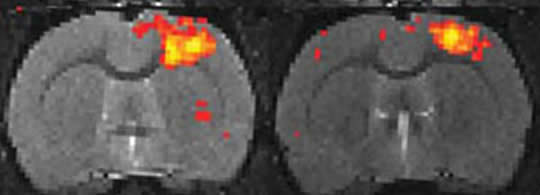fMRI, Neuron Data Validated
Brain scans using fMRI (functional magnetic resonance imaging) don’t always get a lot of respect. They have been accused of being used to produce research that is colorful but not particularly insightful. One study used fMRI to find activity in the brains of dead salmon (Are Brain Scan Findings Fishy?). Some have even suggested that much of what fMRI scans show is meaningless “chaff,” since the scans don’t measure actual neuronal activity but rather changes in blood flow and oxygen levels in the brain. Now, new research published in Nature has shown that there is indeed a correlation between neuronal activity and what the fMRI can measure:
The researchers, led by Jin Hyung Lee of the Department of Electrical Engineering, Psychiatry and Biobehavioral Sciences at the University of California, Los Angeles, and Remy Durand of the Department of Bioengineering at Stanford University, were able to show specific target neurons “light up” on the fMRI scans when they activated them with light pulses.
The researchers used an approach called optogenetics, in which genetically engineered neurons are controlled by light pulses, in mice under general anesthesia. And when the team manually activated particular brain cells with the pulses, those areas flashed on the fMRI screen as well, which suggests that the blood flow changes seen in fMRIs do seem to be evidence for neuron activity in that location. [From ScientificAmerican.com – New evidence that fMRI experiments are valid measure of neuron activity by Katherine Harmon.]
No doubt these findings will be greeted with a collective, “Well, duhhh!” from serious fMRI researchers who have been using the technology successfully for years. Still, this research does apparently eliminate one basis for criticism of fMRI findings.
Of course, the fact that fMRI scans actually do reflect neuron activity doesn’t validate interpretations of the collected data, e.g., whether a criminal suspect is lying or whether an advertisement will sell product (see Super Bowl Ads: GoDaddy Girl 1, Neuroscientists 0).
The team’s effort may actually extend the use of fMRI brain scan technology:
They found that they could use optogenetics to produce activity in specific kinds of cells in neural circuits, and then read out the far-reaching effects with fMRI BOLD over a substantial distance in the brain.
In one experiment, for example, the team could see how activity they stimulated in the thalamus, a key relay center deep in the brain, could affect circuits stretching into the somatosensory cortex, a surface brain region important in processing sensation.
“We can now ask what the true impact of a cell type is on global activity in the brain of a living mammal,” Deisseroth said. “A key to scientific inquiry is developing tools that allow us to intervene and experiment with brain circuits — engineering a reversible gain or loss of function — rather than simple observation of correlations. This points to new approaches for understanding and treatment.” [From Stanford School of Medicine – Stanford-led team validates, extends fMRI research on brain activity by David Orenstein.]
It remains to be seen whether fMRI will gain ground as a neuromarketing tool. The field has been increasingly dominated by EEG, a very different technology that is cheaper, more convenient, and faster, but which can’t offer three-dimensional localization of brain activity.

